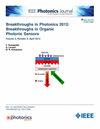Microlens Array-Based Beam Profile and Wavefront Sensor With Physical Constraint Learning
IF 2.4
4区 工程技术
Q3 ENGINEERING, ELECTRICAL & ELECTRONIC
引用次数: 0
Abstract
The beam profile and wavefront characteristics of laser beams are essential for numerous laser applications, including micromachining and microfabrication. However, conventional wavefront sensors, such as the Shack-Hartmann wavefront sensor (SHWS), are limited by reduced accuracy in detecting local distortions and sensitivity to non-uniform beam profiles. Additionally, beam profile information is crucial for such applications. This paper introduces a new methodology that utilizes an SHWS-like structure to overcome these limitations. By employing a physical constraint learning approach, the proposed method simultaneously provides highly accurate wavefront and beam profile data. We first develop a pretrained network using microlens array (MLA) simulation datasets. To implement a practical MLA-based measurement system, this pretrained network is further fine-tuned with datasets modulated by a spatial light modulator in the system setup. Experimental results demonstrate that the proposed network can reconstruct both beam profiles and wavefronts in real-time. Compared to traditional SHWS reconstruction techniques, our approach enhances computation speed by over 100 times, while also providing beam intensity profile information and increasing wavefront sensing accuracy by approximately fivefold.基于微透镜阵列的光束轮廓和物理约束学习的波前传感器
激光束的光束轮廓和波前特性对于许多激光应用至关重要,包括微加工和微制造。然而,传统的波前传感器,如Shack-Hartmann波前传感器(SHWS),由于检测局部畸变的精度降低和对非均匀光束轮廓的灵敏度而受到限制。此外,光束轮廓信息对于此类应用至关重要。本文介绍了一种利用类似shws的结构来克服这些限制的新方法。该方法采用物理约束学习方法,同时提供高精度的波前和波束剖面数据。我们首先使用微透镜阵列(MLA)模拟数据集开发了一个预训练网络。为了实现一个实用的基于mla的测量系统,该预训练网络在系统设置中使用空间光调制器调制的数据集进一步微调。实验结果表明,该网络可以实时重建波束轮廓和波前。与传统的SHWS重建技术相比,我们的方法将计算速度提高了100倍以上,同时还提供了波束强度剖面信息,并将波前传感精度提高了约5倍。
本文章由计算机程序翻译,如有差异,请以英文原文为准。
求助全文
约1分钟内获得全文
求助全文
来源期刊

IEEE Photonics Journal
ENGINEERING, ELECTRICAL & ELECTRONIC-OPTICS
CiteScore
4.50
自引率
8.30%
发文量
489
审稿时长
1.4 months
期刊介绍:
Breakthroughs in the generation of light and in its control and utilization have given rise to the field of Photonics, a rapidly expanding area of science and technology with major technological and economic impact. Photonics integrates quantum electronics and optics to accelerate progress in the generation of novel photon sources and in their utilization in emerging applications at the micro and nano scales spanning from the far-infrared/THz to the x-ray region of the electromagnetic spectrum. IEEE Photonics Journal is an online-only journal dedicated to the rapid disclosure of top-quality peer-reviewed research at the forefront of all areas of photonics. Contributions addressing issues ranging from fundamental understanding to emerging technologies and applications are within the scope of the Journal. The Journal includes topics in: Photon sources from far infrared to X-rays, Photonics materials and engineered photonic structures, Integrated optics and optoelectronic, Ultrafast, attosecond, high field and short wavelength photonics, Biophotonics, including DNA photonics, Nanophotonics, Magnetophotonics, Fundamentals of light propagation and interaction; nonlinear effects, Optical data storage, Fiber optics and optical communications devices, systems, and technologies, Micro Opto Electro Mechanical Systems (MOEMS), Microwave photonics, Optical Sensors.
 求助内容:
求助内容: 应助结果提醒方式:
应助结果提醒方式:


